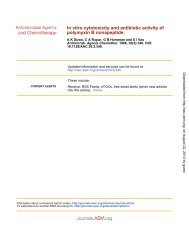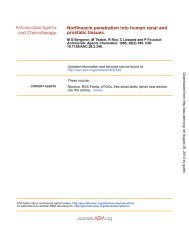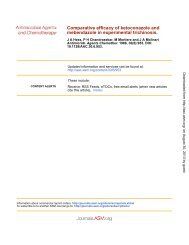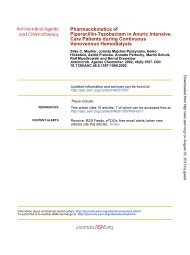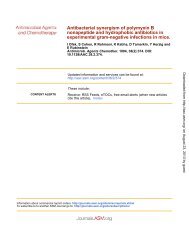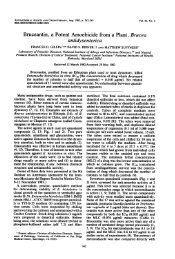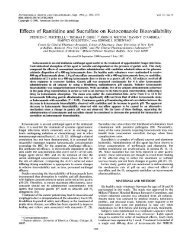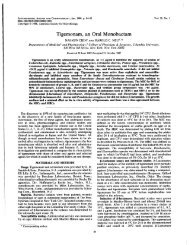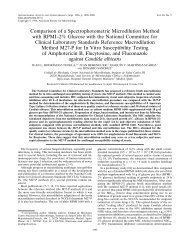In Vitro Susceptibility of Coxiella burnetii to Trovaffoxacin in ...
In Vitro Susceptibility of Coxiella burnetii to Trovaffoxacin in ...
In Vitro Susceptibility of Coxiella burnetii to Trovaffoxacin in ...
You also want an ePaper? Increase the reach of your titles
YUMPU automatically turns print PDFs into web optimized ePapers that Google loves.
<strong>In</strong> <strong>Vitro</strong> <strong>Susceptibility</strong> <strong>of</strong> <strong>Coxiella</strong> <strong>burnetii</strong><br />
<strong>to</strong> Trovafloxac<strong>in</strong> <strong>in</strong> Comparison with<br />
Susceptibilities <strong>to</strong> Pefloxac<strong>in</strong>,<br />
Cipr<strong>of</strong>loxac<strong>in</strong>, Ofloxac<strong>in</strong>, Doxycycl<strong>in</strong>e, and<br />
Clarithromyc<strong>in</strong><br />
Achilleas Gikas, Ioanna Spyridaki, Anna Psaroulaki,<br />
Diamantis K<strong>of</strong>terithis and Yannis Tselentis<br />
Antimicrob. Agents Chemother. 1998, 42(10):2747.<br />
REFERENCES<br />
CONTENT ALERTS<br />
Updated <strong>in</strong>formation and services can be found at:<br />
http://aac.asm.org/content/42/10/2747<br />
These <strong>in</strong>clude:<br />
This article cites 12 articles, 10 <strong>of</strong> which can be accessed free<br />
at: http://aac.asm.org/content/42/10/2747#ref-list-1<br />
Receive: RSS Feeds, eTOCs, free email alerts (when new<br />
articles cite this article), more»<br />
Downloaded from http://aac.asm.org/<br />
on August 31, 2013 by guest<br />
<strong>In</strong>formation about commercial repr<strong>in</strong>t orders: http://journals.asm.org/site/misc/repr<strong>in</strong>ts.xhtml<br />
To subscribe <strong>to</strong> <strong>to</strong> another ASM Journal go <strong>to</strong>: http://journals.asm.org/site/subscriptions/
ANTIMICROBIAL AGENTS AND CHEMOTHERAPY, Oct. 1998, p. 2747–2748 Vol. 42, No. 10<br />
0066-4804/98/$04.000<br />
Copyright © 1998, American Society for Microbiology. All Rights Reserved.<br />
<strong>In</strong> <strong>Vitro</strong> <strong>Susceptibility</strong> <strong>of</strong> <strong>Coxiella</strong> <strong>burnetii</strong> <strong>to</strong> Trovafloxac<strong>in</strong> <strong>in</strong><br />
Comparison with Susceptibilities <strong>to</strong> Pefloxac<strong>in</strong>,<br />
Cipr<strong>of</strong>loxac<strong>in</strong>, Ofloxac<strong>in</strong>, Doxycycl<strong>in</strong>e,<br />
and Clarithromyc<strong>in</strong><br />
ACHILLEAS GIKAS,* IOANNA SPYRIDAKI, ANNA PSAROULAKI,<br />
DIAMANTIS KOFTERITHIS, AND YANNIS TSELENTIS<br />
Cl<strong>in</strong>ical Bacteriology, Parasi<strong>to</strong>logy, Zoonoses, and Geographical Medic<strong>in</strong>e, University Hospital<br />
<strong>of</strong> Heraklion, 1352/71110 Crete, Greece<br />
Received 24 April 1998/Returned for modification 28 May 1998/Accepted 16 July 1998<br />
The antibiotic susceptibilities <strong>of</strong> eight Greek isolates <strong>of</strong> <strong>Coxiella</strong> <strong>burnetii</strong> <strong>to</strong> trovafloxac<strong>in</strong> were determ<strong>in</strong>ed by<br />
the shell vial assay. MICs <strong>of</strong> trovafloxac<strong>in</strong> and <strong>of</strong>loxac<strong>in</strong> ranged from 1 <strong>to</strong> 2 g/ml, those <strong>of</strong> pefloxac<strong>in</strong> ranged<br />
from1<strong>to</strong>4g/ml, those <strong>of</strong> cipr<strong>of</strong>loxac<strong>in</strong> ranged from 4 <strong>to</strong> 8 g/ml, those <strong>of</strong> doxycycl<strong>in</strong>e ranged from 1 <strong>to</strong> 2 g/<br />
ml, and those <strong>of</strong> clarithromyc<strong>in</strong> ranged from 2 <strong>to</strong> 4 g/ml. Trovafloxac<strong>in</strong> exhibited no activity aga<strong>in</strong>st C. <strong>burnetii</strong><br />
at 4 g/ml.<br />
<strong>Coxiella</strong> <strong>burnetii</strong> is the etiologic agent <strong>of</strong> Q fever. Two major<br />
forms <strong>of</strong> the disease are known: acute and chronic (1). The<br />
acute form <strong>of</strong> the disease is usually a self-limit<strong>in</strong>g acute febrile<br />
illness, dur<strong>in</strong>g which pneumonia or hepatitis may occur. However,<br />
the chronic form is a severe disease <strong>in</strong> which endocarditis<br />
predom<strong>in</strong>ates (8). Whereas acute C. <strong>burnetii</strong> <strong>in</strong>fections respond<br />
<strong>to</strong> antibiotic therapy, chronic <strong>in</strong>fections are hard <strong>to</strong> cure<br />
(3, 12).<br />
The efficacies <strong>of</strong> qu<strong>in</strong>olones aga<strong>in</strong>st these types <strong>of</strong> <strong>in</strong>fection<br />
have yet <strong>to</strong> be established. <strong>In</strong> this paper we studied the activity<br />
<strong>of</strong> a new qu<strong>in</strong>olone, trovafloxac<strong>in</strong>, aga<strong>in</strong>st C. <strong>burnetii</strong>, us<strong>in</strong>g<br />
Vero cell tissue cultures. We also compared its bacteriostatic<br />
effect with those <strong>of</strong> five other antibiotic compounds on eight<br />
Greek isolates derived from human samples.<br />
S<strong>to</strong>ck solutions <strong>of</strong> trovafloxac<strong>in</strong> (20 mg/ml; k<strong>in</strong>dly provided<br />
by Pfizer <strong>In</strong>c., New York, N.Y.), pefloxac<strong>in</strong> (400 mg/5 ml;<br />
Rhone Poulenc S.A., Paris, France), cipr<strong>of</strong>loxac<strong>in</strong> (100 mg/50<br />
ml; Bayer AG, Leverkuzen, Germany), and <strong>of</strong>loxac<strong>in</strong> (220 mg/<br />
100 ml; Hoechst AG, Frankfurt am Ma<strong>in</strong>, Germany) were prepared.<br />
For doxycycl<strong>in</strong>e (Pfizer <strong>In</strong>c.) and clarithromyc<strong>in</strong> (Abbott<br />
Labora<strong>to</strong>ries, Chicago, Ill.), s<strong>to</strong>ck solutions at 6 mg/ml<br />
were prepared by us<strong>in</strong>g methanol.<br />
All stra<strong>in</strong>s were grown <strong>in</strong> Vero cells as previously described<br />
(10). The bacteriostatic and bactericidal effects on C. <strong>burnetii</strong><br />
were tested by the shell vial assay. For this purpose an acute<strong>in</strong>fection<br />
model with the N<strong>in</strong>e-Mile stra<strong>in</strong> and a chronic-<strong>in</strong>fection<br />
model with the Q212 stra<strong>in</strong> were employed (1, 10). <strong>In</strong><br />
addition, the concentration <strong>of</strong> the <strong>in</strong>oculum that was previously<br />
determ<strong>in</strong>ed <strong>to</strong> <strong>in</strong>fect 30 <strong>to</strong> 50% <strong>of</strong> Vero cells was used <strong>to</strong> <strong>in</strong>fect<br />
the shell vials for the antibiotic challenge (10). Bacterial growth<br />
was evaluated after 6 days <strong>of</strong> <strong>in</strong>cubation by <strong>in</strong>direct immun<strong>of</strong>luorescence,<br />
and the results were scored as follows: R for<br />
resistance, with growth comparable <strong>to</strong> that <strong>of</strong> the control; I for<br />
<strong>in</strong>termediate susceptibility, with less than 10% <strong>in</strong>fected cells;<br />
and S for susceptibility, with the absence <strong>of</strong> <strong>in</strong>fected cells (10).<br />
* Correspond<strong>in</strong>g author. Mail<strong>in</strong>g address: Cl<strong>in</strong>ical Bacteriology,<br />
Parasi<strong>to</strong>logy, and Geographical Medic<strong>in</strong>e, University Hospital <strong>of</strong> Heraklion,<br />
1352/71110 Crete, Greece. Phone: 30-81-392360. Fax: 30-81-<br />
392847. E-mail: achille@edu.uch.gr.<br />
2747<br />
The bactericidal activity <strong>of</strong> trovafloxac<strong>in</strong> was assessed by the<br />
quantitative method described by Maur<strong>in</strong> and Raoult (6). Trovafloxac<strong>in</strong><br />
was added <strong>to</strong> the culture medium at 4 g/ml. Viable<br />
organisms were identified after 6 days <strong>in</strong> the culture, and bactericidal<br />
activity corresponded <strong>to</strong> a significant reduction <strong>in</strong> bacterial<br />
titer (at least 2 <strong>to</strong> 3 dilutions) after antibiotic exposure,<br />
compared with that <strong>in</strong> the primary <strong>in</strong>oculum dose (5, 6).<br />
Trovafloxac<strong>in</strong> showed bacteriostatic activity <strong>to</strong>ward C. <strong>burnetii</strong>.<br />
Complete bacterial growth <strong>in</strong>hibition was obta<strong>in</strong>ed with<br />
1 g per ml <strong>in</strong> tests with the N<strong>in</strong>e-Mile isolate and with seven<br />
<strong>of</strong> eight Greek isolates. <strong>In</strong>hibition was also obta<strong>in</strong>ed with 2<br />
g/ml <strong>in</strong> tests with the Q212 stra<strong>in</strong> and the last Greek isolate<br />
(Table 1). These concentrations are below those achieved <strong>in</strong><br />
human serum with the recommended s<strong>in</strong>gle oral dose <strong>of</strong> 200<br />
mg <strong>of</strong> trovafloxac<strong>in</strong> (2.2 g/ml).<br />
Vero cells were persistently <strong>in</strong>fected with the N<strong>in</strong>e-Mile and<br />
Q212 C. <strong>burnetii</strong> stra<strong>in</strong>s for 5 months before be<strong>in</strong>g tested. Only<br />
these two stra<strong>in</strong>s were tested <strong>in</strong> bactericidal experiments with<br />
trovafloxac<strong>in</strong>. No bactericidal activity was demonstrated with 4<br />
g <strong>of</strong> trovafloxac<strong>in</strong> per ml when these cells were exam<strong>in</strong>ed.<br />
All MICs recorded were compared with each other and with<br />
the peak concentration <strong>of</strong> each antibiotic <strong>in</strong> serum. The MICs<br />
<strong>of</strong> all the antibiotics tested are summarized <strong>in</strong> Table 2.<br />
At the concentrations tested, trovafloxac<strong>in</strong>, <strong>of</strong>loxac<strong>in</strong>, and<br />
doxycycl<strong>in</strong>e showed improved bacteriostatic activities <strong>in</strong> vitro<br />
TABLE 1. Susceptibilities <strong>of</strong> C. <strong>burnetii</strong> stra<strong>in</strong>s <strong>to</strong> trovafloxac<strong>in</strong><br />
determ<strong>in</strong>ed by the shell vial technique<br />
Trovafloxac<strong>in</strong><br />
concn<br />
(g/ml)<br />
<strong>Susceptibility</strong> a <strong>of</strong> <strong>in</strong>dicated stra<strong>in</strong><br />
N<strong>in</strong>e Mile Q212 CP1 CP2 CP3 CP4 CP5 CP6 CP7 CP8<br />
0.25 R R R R R R R R R R<br />
0.5 I R R I I I I I I I<br />
1.0 S I I S S S S S S S<br />
2.0 S S S S S S S S S S<br />
4.0 S S S S S S S S S S<br />
8.0 S S S S S S S S S S<br />
16.0 S S S S S S S S S S<br />
a See the text.<br />
Downloaded from http://aac.asm.org/ on August 31, 2013 by guest
2748 NOTES ANTIMICROB. AGENTS CHEMOTHER.<br />
Isolate<br />
TABLE 2. Antibiotic susceptibilities <strong>of</strong> C. <strong>burnetii</strong> isolates<br />
Pefloxac<strong>in</strong><br />
at<br />
PCS a 3.8<br />
Ofloxac<strong>in</strong><br />
at<br />
PCS 3<br />
MIC (g/ml) <strong>of</strong>:<br />
Cipr<strong>of</strong>loxac<strong>in</strong><br />
at<br />
PCS 1.6<br />
Trovafloxac<strong>in</strong><br />
at<br />
PCS 2.2<br />
Clarithromyc<strong>in</strong><br />
at<br />
PCS 4<br />
Doxycycl<strong>in</strong>e<br />
at<br />
PCS 4.4<br />
N<strong>in</strong>e Mile 1 1 4 1 2 1<br />
Q212 4 2 8 2 4 2<br />
CP1 4 2 8 2 4 2<br />
CP2 1 1 4 1 2 1<br />
CP3 1 1 4 1 2 1<br />
CP4 2 1 4 1 2 2<br />
CP5 1 1 4 1 2 1<br />
CP6 1 1 4 1 2 1<br />
CP7 1 1 4 1 2 1<br />
CP8 1 1 4 1 2 1<br />
a PCS, peak concentration <strong>in</strong> serum (<strong>in</strong> micrograms per milliliter) for a s<strong>in</strong>gle<br />
dose <strong>of</strong> antibiotic.<br />
<strong>in</strong> tests with the Greek C. <strong>burnetii</strong> isolates as well as the tested<br />
reference stra<strong>in</strong>s. However, the same isolates were less susceptible<br />
<strong>to</strong> pefloxac<strong>in</strong> and clarithromyc<strong>in</strong>. Cipr<strong>of</strong>loxac<strong>in</strong> presented<br />
higher MICs for all tested stra<strong>in</strong>s.<br />
Two major problems are associated with the evaluation <strong>of</strong><br />
the antibiotic treatment <strong>of</strong> acute Q fever. First, it is usually a<br />
self-limited disease and mostly retrospectively diagnosed and<br />
<strong>in</strong> the chronic form, an evaluation <strong>of</strong> the success <strong>of</strong> therapy<br />
requires prolonged follow-up due <strong>to</strong> late relapses (3–5, 7–9).<br />
Second, the experimental evaluation <strong>of</strong> antibiotic therapy is<br />
problematic because C. <strong>burnetii</strong> is a strictly <strong>in</strong>tracellular pathogen<br />
and no successful animal model <strong>of</strong> chronic Q fever has<br />
been described so far (9). <strong>In</strong> cases <strong>of</strong> acute Q fever, a bacteriostatic<br />
effect is sufficient for enabl<strong>in</strong>g recovery, whereas <strong>in</strong><br />
cases <strong>of</strong> chronic Q fever, a bacteriostatic regimen is not curative<br />
(9).<br />
Tetracycl<strong>in</strong>e has been the ma<strong>in</strong>stay therapy for endocarditis<br />
(8, 9). However, recovery <strong>of</strong> viable C. <strong>burnetii</strong> from valve tissue<br />
after 4 years <strong>of</strong> therapy with doxycycl<strong>in</strong>e has been reported (8).<br />
The use <strong>of</strong> cotrimoxazole alone has failed <strong>to</strong> cure Q fever endocarditis<br />
(8, 9). Comb<strong>in</strong>ations <strong>of</strong> rifamp<strong>in</strong> with either doxycycl<strong>in</strong>e<br />
or cotrimoxazole have been used <strong>in</strong> treat<strong>in</strong>g Q fever<br />
endocarditis, with apparent success (9). Cl<strong>in</strong>ical data on the<br />
efficacies <strong>of</strong> macrolides are lack<strong>in</strong>g (4).<br />
More recently, a comb<strong>in</strong>ation <strong>of</strong> doxycycl<strong>in</strong>e with the lysosomotropic<br />
agent chloroqu<strong>in</strong>e displayed bactericidal activity <strong>in</strong><br />
vitro, but no def<strong>in</strong>itive cl<strong>in</strong>ical data were presented (4). Qu<strong>in</strong>olones<br />
exhibit <strong>in</strong> vitro activities aga<strong>in</strong>st rickettsiae and have<br />
produced encourag<strong>in</strong>g cl<strong>in</strong>ical results <strong>in</strong> Q fever patients (2,<br />
3). <strong>In</strong> our study, trovafloxac<strong>in</strong> showed bacteriostatic activities<br />
(MIC, 1 <strong>to</strong> 2 g/ml) <strong>in</strong> tests with C. <strong>burnetii</strong> stra<strong>in</strong>s that were<br />
better than those obta<strong>in</strong>ed with pefloxac<strong>in</strong>, clarithromyc<strong>in</strong>, and<br />
cipr<strong>of</strong>loxac<strong>in</strong>. The bacteriostatic activities <strong>of</strong> doxycycl<strong>in</strong>e and<br />
<strong>of</strong>loxac<strong>in</strong> were comparable <strong>to</strong> those <strong>of</strong> trovafloxac<strong>in</strong>.<br />
A comparison between its MIC and peak concentration <strong>in</strong><br />
serum cannot be used as evidence <strong>of</strong> trovafloxac<strong>in</strong>’s cl<strong>in</strong>ical<br />
efficacy, s<strong>in</strong>ce C. <strong>burnetii</strong> is an <strong>in</strong>tracellular pathogen. It is,<br />
however, <strong>in</strong>terest<strong>in</strong>g that the <strong>in</strong>tracellular concentrations <strong>of</strong><br />
cipr<strong>of</strong>loxac<strong>in</strong> for all the tested stra<strong>in</strong>s and those <strong>of</strong> pefloxac<strong>in</strong><br />
for two stra<strong>in</strong>s (Q212 and CP1) needed <strong>to</strong> be higher than their<br />
peak concentrations <strong>in</strong> serum <strong>in</strong> order <strong>to</strong> achieve bacteriostatic<br />
levels. This was not true for the other qu<strong>in</strong>olones tested. The<br />
same type <strong>of</strong> comparison produced favorable results for clarithromyc<strong>in</strong><br />
and doxycycl<strong>in</strong>e (Table 2). However, the determ<strong>in</strong>ation<br />
<strong>of</strong> the activities <strong>of</strong> trovafloxac<strong>in</strong> aga<strong>in</strong>st C. <strong>burnetii</strong><br />
stra<strong>in</strong>s showed that at a concentration <strong>of</strong> 4 g/ml, it was not<br />
bactericidal <strong>to</strong> either tested stra<strong>in</strong>.<br />
<strong>In</strong> conclusion, our results <strong>in</strong>dicate that trovafloxac<strong>in</strong> possesses<br />
promis<strong>in</strong>g <strong>in</strong> vitro activities aga<strong>in</strong>st bacteria <strong>of</strong> the<br />
C. <strong>burnetii</strong> species. Careful cl<strong>in</strong>ical studies are now required <strong>to</strong><br />
evaluate it for the treatment <strong>of</strong> Q fever <strong>in</strong>fection.<br />
REFERENCES<br />
1. Jabarit-Aldighieri, N., H. Torres, and D. Raoult. 1992. <strong>Susceptibility</strong> <strong>of</strong><br />
Rickettsia conori, R. rickettsii, and <strong>Coxiella</strong> <strong>burnetii</strong> <strong>to</strong> PD 127,391, PD 131,628,<br />
pefloxac<strong>in</strong>, <strong>of</strong>loxac<strong>in</strong>, and cipr<strong>of</strong>loxac<strong>in</strong>. Antimicrob. Agents Chemother. 36:<br />
2529–2532.<br />
2. Keren, G., A. Keysary, R. Goldwasser, and E. Rub<strong>in</strong>ste<strong>in</strong>. 1994. The <strong>in</strong>hibi<strong>to</strong>ry<br />
effect <strong>of</strong> fluoroqu<strong>in</strong>olones on <strong>Coxiella</strong> <strong>burnetii</strong> growth <strong>in</strong> <strong>in</strong>-vitro systems.<br />
J. Antimicrob. Chemother. 33:1253–1255.<br />
3. Levy, P. Y., M. Drancourt, J. Etienne, J. C. Auvergnat, J. Bey<strong>to</strong>ut, J. M.<br />
Sa<strong>in</strong>ty, F. Goldste<strong>in</strong>, and D. Raoult. 1991. Comparison <strong>of</strong> different antibiotic<br />
regimens for therapy <strong>of</strong> 32 cases <strong>of</strong> Q fever endocarditis. Antimicrob. Agents<br />
Chemother. 35:533–537.<br />
4. Maur<strong>in</strong>, M., and D. Raoult. 1996. Optimum treatment <strong>of</strong> <strong>in</strong>tracellular <strong>in</strong>fection.<br />
Drugs 52:45–49.<br />
5. Maur<strong>in</strong>, M., A. M. Benoliel, P. Bongrand, and D. Raoult. 1992. Phagolysosomal<br />
alkal<strong>in</strong>ization and the bactericidal effect <strong>of</strong> antibiotics: the <strong>Coxiella</strong><br />
<strong>burnetii</strong> paradigm. J. <strong>In</strong>fect. Dis. 166:1097–1102.<br />
6. Maur<strong>in</strong>, M., and D. Raoult. 1993. <strong>In</strong> vitro susceptibilities <strong>of</strong> spotted fever<br />
group rickettsiae and <strong>Coxiella</strong> <strong>burnetii</strong> <strong>to</strong> clarithromyc<strong>in</strong>. Antimicrob. Agents<br />
Chemother. 37:2633–2637.<br />
7. Raoult, D. 1991. Antibiotic treatment <strong>of</strong> rickettsiosis, recent advances and<br />
current concepts. Eur. J. Epidemiol. 7:276–281.<br />
8. Raoult, D. 1993. Treatment <strong>of</strong> Q fever. Antimicrob. Agents Chemother. 37:<br />
1733–1736.<br />
9. Raoult, D., and T. Marrie. 1995. Q fever. Cl<strong>in</strong>. <strong>In</strong>fect. Dis. 20:489–496.<br />
10. Raoult, D., H. Torres, and M. Drancourt. 1991. Shell-vial assay: evaluation<br />
<strong>of</strong> a new technique for determ<strong>in</strong><strong>in</strong>g antibiotic susceptibility, tested <strong>in</strong> 13<br />
isolates <strong>of</strong> <strong>Coxiella</strong> <strong>burnetii</strong>. Antimicrob. Agents Chemother. 35:2070–2077.<br />
11. Torres, H., and D. Raoult. 1993. <strong>In</strong> vitro activities <strong>of</strong> ceftriaxone and fusidic<br />
acid aga<strong>in</strong>st 13 isolates <strong>of</strong> <strong>Coxiella</strong> <strong>burnetii</strong>, determ<strong>in</strong>ed us<strong>in</strong>g the shell vial<br />
assay. Antimicrob. Agents Chemother. 37:491–494.<br />
12. Tselentis, Y., A. Gikas, D. Kodteridis, E. Kyriakakis, N. Lydataki, D. Bouros,<br />
and N. Tsaparas. 1995. Q fever <strong>in</strong> the Greek island <strong>of</strong> Crete: epidemiological,<br />
cl<strong>in</strong>ical, and therapeutic data from 98 cases. Cl<strong>in</strong>. <strong>In</strong>fect. Dis. 20:1311–<br />
1316.<br />
13. Yeaman, M. R., L. A. Mitscher, and O. G. Baca. 1987. <strong>In</strong> vitro susceptibility<br />
<strong>of</strong> <strong>Coxiella</strong> <strong>burnetii</strong> <strong>to</strong> antibiotics, <strong>in</strong>clud<strong>in</strong>g several qu<strong>in</strong>olones. Antimicrob.<br />
Agents Chemother. 31:1079–1084.<br />
Downloaded from http://aac.asm.org/ on August 31, 2013 by guest




